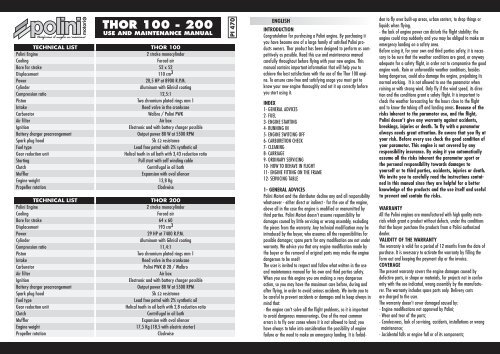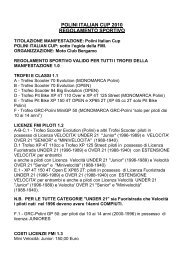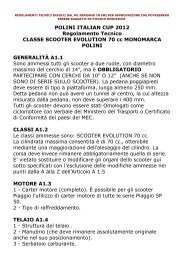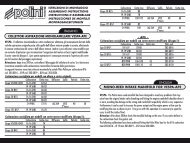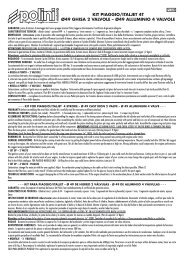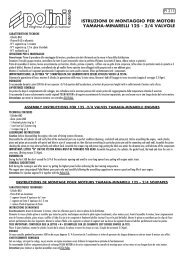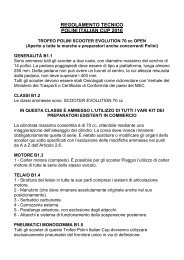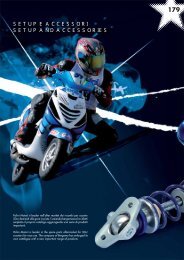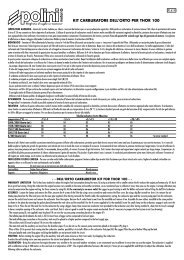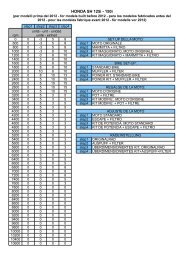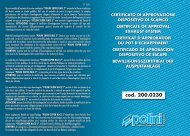THOR 100 - 200 - Polini
THOR 100 - 200 - Polini
THOR 100 - 200 - Polini
Create successful ePaper yourself
Turn your PDF publications into a flip-book with our unique Google optimized e-Paper software.
- Engine improper use or misusage;- Assembly of parts or components not specified for the engineuse;- Engine overheating or stop after long usage, beyond the termindicated by <strong>Polini</strong>;- Missing or irregular engine servicing as suggested by <strong>Polini</strong>, useof improper petrol or oils, presence of dirty parts or foreignbodies in the engine, even sucked;- Engine overwork because overloaded;- Engine or parts deterioration because of improperly storage;- Faulty engine assembly, including the use of not original <strong>Polini</strong>parts or coming from third parties;- Damages to the engine caused by foreign bodies;- Servicing operated by person outside <strong>Polini</strong> or by not authorized people;- Competition use of the engine.Final user obligationsClaims shall be done by delivering the engine to a <strong>Polini</strong> authorizeddealer. The user shall provide the original document that provesthe purchasing or the warranty ticket authenticated by <strong>Polini</strong>or by its distributor. To keep the validity of the warranty the usershall carry out recurrent servicing according to the use and maintenancemanual.Limited liabilityPursuant to this warranty, <strong>Polini</strong>’s obligations are limited to thedefective parts reparation or, at its discretion, to change one ormore parts, necessary to remedy every malfunctioning caused bydefective materials or labor covered by the warranty. <strong>Polini</strong> orthe distributor can’t be held responsible for problems or damagesto persons/things/animals during the engine life. We remindyou that this product is not certificated and it is onlydedicated to experimental aircraft and that it can break orsuddenly stop working. No warranty or compensation are foreseenfor damages caused to:- persons/animals/things during the engine use- persons/animals/things caused by a collide with the propelleror with parts detached from the engine- frame, parts and/or propeller caused by the collide with partscoming out from the engine- costs for rescue, shipping, phone or rent after the collide,problems or loss of time, or other indirect damages.DANGER! This not-certified engine can suddenly stop working.The engine stop can require emergency landings causinginjuries or death. The aircraft thrusts by this engine should fly inopen spaces only or during the daylight. The buyer assumes allthe risks for the use and he knows that by using it the engine cansuddenly stop working. This product is not covered by productsand public liability. Who flies with a paramotor or onlyswitches it on assumes all the risks inherent to theparagliding sport and all the responsibilities for damagesto things or persons or death caused by the use ofthis product.2- FUELThor <strong>100</strong>/<strong>200</strong> is a 2-stroke engine that needs oil/petrol mixture.Only use good lead-free petrol purchased by a petrol station with98 octane. Add good 2% synthetic oil to the petrol. It is possibleto use a 1,5% oil mixture with the following oils:MOTUL 800 - CASTROL 242 - BARDAL KXT - ELF 976 - ELF 909.WARNING: The nature of the carbon deposits on the cylinderhead, spark plug and exhaust port give important informationabout the fuel mixture burning in your engine. Remember thatmixes that contain too much oil do not extend the engine’s life.ATTENTION: petrol is extremely inflammable and explosive.Carry out these operations in a well ventilate place and withthe engine switched off. Refrain from smoking and avoid allnaked flames or sparks where petrol is being drained or wherere-fuelling is being performed.3- ENGINE STARTINGStart the engine only when all is in good conditions and perfectlyworking. Furthermore check that all the nuts are well tightened.3.1 WALBRO CARBURATOR (<strong>THOR</strong> <strong>100</strong>-<strong>200</strong>)First cold starting: fill in the fuel system using the pump provided(carefully follow the instructions provided by the frame’s manufacturerto find out it and use it in the correct way). To make thisoperation easier push softly with a finger the diaphragm throughthe hole indicated by the arrow in photo 1. Fill it in till the petrolreaches the carburettor. At that moment immediately stop; if yougo on acting on the pump the petrol will leak causing the engineflooding.01WALBRO WG8 CARBURETOR (<strong>THOR</strong> <strong>100</strong> engine only):Move the starter level to the off position (photo 1); now hand thestarter and start pulling the rope till it grows hard. Pull withstrength without accelerating till the engine seems to start working(do not repeat this operation more than 3 times otherwisethe engine may flood). Now move the starter lever to the onposition (photo 2) and act on the starting rope without accelerating.If the engine doesn’t work with the first two attempts, tryagain accelerating gently.023.2 24/28 PWK CARBURETORFill in the fuel system till the petrol reaches the carburetor holeand then pump up three times (using the pump provided- Code316.0016) to fill out the bowl. To start the engine pull upwardsthe black level placed in the upper side of the carburettor.Work the starter without accelerating till the engine start. Once itworks switch it off, disconnect the starter and start the engineagain slightly accelerating. For your safety only start the engineafter your harness has been COMPLETELY fixed!3.3 <strong>THOR</strong> <strong>200</strong> ENGINE STARTING WITH ELECTRICSTARTERAccording to the carburettor model (Pwk or Walbro WB37) referto section 3.1 and 3.2 to fill in the fuel system. For the modelwith electric starter the <strong>Polini</strong> throttle system has 3 buttons on thebottom part of the throttle device. To start both the engines pushthe black buttons together and slightly accelerate. For your safetyonly proceed with this operation after your harness has beenCOMPLETELY fixed!ATTENTION: keep the switch in your hand during all the stagesand be ready to work it in case of any anomaly. If necessarykeep it pressed till the engine has completely stopped.Once the engine starts we suggest testing the right functioning ofthe kill switch button. After having checked it, start the engineagain without accelerating and without using the starter. Nowstart the engine and leave it idle until it warms up to normaltemperature.4- RUNNING INRun your engine in as instructed below to ensure that the engineand transmission bed in correctly and to ensure continuous reliabilityin future. Once the engine starts, leave it idle until it warmsup to normal temperature. We suggest running the engine 15minutes at medium-low engine power output gently acceleratingand with different intensity. Now we suggest checking the correctidling calibration.During the first flights or for the first 20 litres of petrol we suggestnot keeping the engine at the maximum rpm for too muchtime, considering that the 2-stroke engine doesn’t stand to theconstant rpm even if of medium power. We suggest varying theengine rpm. Check the carburetion after the first landing (section6). Repeat the running in every time you change one of the followingparts: piston, rings, cylinder, crankshaft or main bearings.5- ENGINE SWITCING OFFSwitch the engine off by pressing the button till the complete stop(see the frame manufacturer’s instructions to find the buttonposition)6- CARBURETION CHECKFor a complete carburetion check switch the engine off afterhaving worked it for some minutes under load. Remove thespark plug; unscrew it by using the proper key and verify thatthe porcelain colour is light-brown. On the contrary, ask to anauthorized dealer for the calibration.7- CLEANINGClean the engine when it is switched off and cold to avoid burns.Clean the engine with a soft cloth soaked with neutral cleansingand non-aggressive.WARNING: Do not use acids that may damage the engine.8-CARRIAGEATTENTION: Carry the engine only when cold. Follow theframe manufacturer’s instructions for its carriage. Be careful ofthe petrol during the carriage; its leaking may cause a fire.8.1 CARRIAGE OF THE ENGINE WITH PWKCARBURETORPWK carburetor has a breather pipe studied to carry the enginewhen lying. To empty the carburettor unscrew half turn the breatherbrass nut (highlighted in photo 3 with an arrow) and wait tillthe fuel enters the tank. Close the brass connection again. Nowthe carburettor is empty and you can lay the engine ready to becarry.ATTENTION: never unscrew more than half a turn the breathernut to avoid damaging the OR seal. Never close too hard.
039.2- CHECKING OF THE GEAR OIL LEVELOperate when the engine is cold. Maintain the engine in verticalposition and remove the oil level screw on the transmissioncrankcase. (photo 4). Check that the oil level reaches the loweredge of the level hole. If there is too much oil, let it flow outfrom the level hole until it stops flowing and collect the oil in asuitable container. If there is not enough oil, top up as requiredthrough the breather hole located at the top. After checking it,tighten the screws. Use ELF Moto Gear Oil 10 W 40 ANTI ClutchSlippage or Shell advance gear SAE 10 W 40 API GL-30405079- ORDINARY SERVICING5.108ATTENTION: THE SERVICING OPERATIONS MUST BE DONEBY QUALIFIED PEOPLE ONLY. IF THE INSTRUCTIONS MENTIONEDBELOW WILL RESULT NOT CLEAR, WE SUGGEST ASKING FORSPECIALISTS BY POLINI MOTORI RETAILERS OR WHOLESALERS.FOLLOW CAREFULLY WHAT DESCRIBED BELOW.Maintenances and servicing necessary for the best set up of yourengine should be done regularly, or on all occasions before youstart flying. All the tasks and adjustments described below can bedone easily by following the instructions given in this manual.Refer to your POLINI MOTORI dealer for scheduled services andrepairs, and insist that only original spare parts are used toreplace worn or broken components. Refer to the servicing tablesin sections 12 below for the frequency with which the various servicingoperations must be performed.9.1- REMOVE AND CLEAN THE AIR FILTERDirty air filter is one of the most common causes of poor engineperformance.Clean the filter periodically or change it. Remove the filter looseningthe clamps, unscrew the 4 screws using a cross screwdriver,remove the filter cover and then the filter. Wash the filteringmaterial with water and mild soap,After rinsing and wringing the filter, moisten it with oil for filters.Clean filter box inside using a cloth and check the presence offoreign bodies. Now reassemble all the parts being careful toplace correctly the 4 bars that maintain the filter in its positionand screw the 4 screws again. Wash the filter for maximum 2-3times, then replace it.WARNING. If the filter becomes clogged with fine dust aswell as normal dirt, replace it with a new one.WARNING. Dirty air filters choke the engine and cause poorperformance. Torn or broken filters can allow dirt to enter theengine and cause rapid deterioration of the piston rings, pistonand barrel.AOIL LEVEL9.3 GEAR OIL REPLACEMENTChange the oil when the engine is cold. Unscrew the screw on thelower side of the clutch/gear group. Collect the oil flowing out ina suitable container. Wait till the oil has completely flown outand, if necessary, tilt the engine to the side to make this operationeasier. Tighten the screws. Unscrew the breather pipe in thetop side of the crankcase and fill it out with:(FOR <strong>THOR</strong> <strong>100</strong> ENGINE) 25cc of ELF MOTO GEAR OIL 10 W 40ANTI CLUTCH SLIPPAGE. Place the connection/breather again.(FOR <strong>THOR</strong> <strong>200</strong> ENGINE) <strong>100</strong>cc of ELF MOTO GEAR OIL 10 W 40ANTI CLUTCH SLIPPAGE. Place the connection/breather again.Another option is: Shell Advance Gear SAE 10 W 40 API GL-3WARNING: Do not throw spent oil into the environment. Disposeof it correctly through authorised collection points.9.4-STARTER ROPE REPLACEMENTRemove the starter from the engine unscrewing the 4 screws(Photo 5).Remove the handle rope. Be careful since the central wheel willturn till the complete spring discharge: keep it and discharge itslowly to avoid damages or possible injuries. Remove the centralscrew and its cover (photo 5.1).Attention! Under the cover there are two teeth for the starterjaw (check their condition and if worn replace them); under them2 small callipers. Be very careful not to lose these small parts.Prepare the new rope and tie a knot at the top. Remove the plasticwheel and the old rope.Thread the new rope in its hole (photo 6), wind the rope on thewheel (according to the entrance sense of the rope on the wheel)(Photo 7). Now insert the plastic wheel in its housing again, thespring, the teeth for the starter jaw and screw the cover again.Now go on by charging the return spring: take the head of therope leaving 5-7 cm coming out the hole with “u” shape on thewheel side. Turn the wheel three times in anti clock wise sense tillit stops in front of the exit hole on the aluminium case. Keepingthe plastic wheel stopped make the rope go through the casehole. Insert the handle and the washer and tie a single knot asshown in photo 8.Reassemble the starter in the engine and screw the 4 M5 screwswith strength (see the tightening torque values table).069.5- WALBRO WG8 AND WB37 CARBURETORDIAPHRAGM CHANGINGRemove the filter unscrewing the clamp by using a cross screwdriver.After removing the accelerator cable from the carburettor,the supplementary spring, the carburettor pipe and the diffusionpipe unscrew the two socket head screws and remove the carburettorfrom the engine. Now place the parts on a flat plane.Remove the upper cover by unscrewing the 4 screws , remove thediaphragm and the gasket, check that the inside part is clean andreassemble by using the new diaphragm and the new gasket(photo 09).09ATTENTION: The carburettor is made of many small andfragile parts. Be very careful during all the phases with particularattention to the idling and its springs; they both must not be touched.
Remove the lower cover by unscrewing the 4 screws (Photo 10),remove the diaphragm and the gasket, check that the inside partis clean in particular the metallic filter provided on the WalbroWG8 model only (Photo 11) and assemble it again using the newdiaphragm and the new gasket. Reassemble the carburettor followingthe instructions in the opposite way, being very careful toplace the gaskets in the right places.1011a richer mixture may limit during the time the exceeding loss ofheat, favouring high temperatures that can compromise the reliabilityof the engine. For these reasons we remind you to followvery carefully the section concerning the servicing.11- ENGINE FITTING ON THE FRAMEThe engine is supplied in a packaging and it is screwed on a cageto protect it during its carriage. Unscrew the 4 M8 screws that fixit and extract the engine. KEEP THE PACKAGING AND ITS CAGEFOR POSSIBLE REPARATIONS UNDER WARRANTY. WARRANTY ISNOT ACCEPTED IF THE ENGINE IS NOT SHIPPED IN THE ORIGINALPACKAGING. The engine must be fixed on the frame using the 4clamps with the silent-block and positioning some spacers (onthe Thor <strong>100</strong> only) if the frame doesn’t have the necessary spaceto fit the manual starter. Refer to the drawing for the enginefixing measures.ATTENTION: The engine must be positioned as indicated inthe picture. To assure a perfect lubrication, do not rotate it.Because of the overall dimensions during the carriage the filter is180° rotated. Do not unscrew the clamp to rotate it to reach theoriginal position. The filter has a hole at the top to be used toavoid its rotation when using. Place the clamp or a small cable(they are not provided with the engine) fixing them in a properzone of the frame.11.3 SPARK PLUGRemove the spark plug and check that the gap between thespark plug electrodes is 0,9mm. Fit the spark plug hood insidethe conveyor cap being careful to fit it completely. Now engageon the spark plug and enter the small rubber inside the hole inthe plastic conveyor (photo 13). Spark plug type: NGK BR10EG1312Connect the negative pole of the battery to earth on the engine.During its working the voltage regulator, if connected in the rightway, will give a 14,5 Vdc voltage on the battery.CBAEDOPTIONAL1410- HOW TO BEHAVE IN FLIGHTMaximum acceleration is recommended only to take off (fullpower) or when really necessary!In order to avoid a poor mixture from acceleration/ascension tolevel flight conditions, loosen the engine till a descending phaseand then gradually accelerate again till achieving a level flightor a glide angle or a rise angle wished. In this way you will besure to maintain firm and efficient the carburation, avoiding tobe over rpm with a minimum valve/throttle opening.Two stroke engines do not stand constant range for a long timetoo much. Take care of your engine by varying now and then therpm range. In this way the engine will have constant performanceand a good elasticity improving its working during the time.10.1 TEMPERATURE THERESHOLDSYour <strong>100</strong>/<strong>200</strong> Thor engine, according to the pilot weight andwind size, must have a flight temperature between 230° and250° under sparkplug (these measures have been taken with<strong>Polini</strong> thermocouple tool – 928.830.002). This parameters mayvary according to different factors: environment temperature,working height, wet, quality of the fuel used, anyway this temperaturehas not to exceed 265°/280 for short period.Furthermore it is important to say that carbon deposits caused byATTENTION: the filter may rotate if you do not fix it and itcould collide with the propeller, breaking it. This may be verydangerous for your safety.11.1 FUEL SYSTEMPrearrange the frame with a proper tank and its pump to makethe fuel reach the carburettor. Connect the fuel pipe to the manifoldon the carburettor, fix it using a clamp and verify that thereis not air coming in.11.2 ACCELERATORFix the carburettor by using the proper accelerator support (notsupplied). After assembling the accelerator, check that its travel isenough to reach the carburettor throttle valve opening and checkthat recovery is good in order to avoid the engine staying accelerated.Check the presence and the right supplementary springinstallation (photo 12) provided with the Thor <strong>100</strong> with Walbrocarburettor only. Connect the electrical wires of the throttle, oneon the mass wire of the coil and the other on the + of the coil(female connector)11.4 PROPELLERUse propellers by <strong>Polini</strong> Motori, both for Thor <strong>100</strong> and <strong>200</strong> . Theuse of a not proper propeller may compromise the engine working.11.5 HOW TO CONNECT THE VOLTAGE REGULATOR(OPTIONAL)Connect the voltage regulator to the connector. Connect the redcable (E) to the positive pole on a lead battery (photo 14).WARNING. Use lead batteries only. The usage of other kindof batteries could provoke explosions or bursts.
12- SERVICING TABLEAt every useAfter the first 10 hoursEvery 25 hoursEvery 50 hoursEvery <strong>100</strong> hours or every yearEvery <strong>100</strong> hoursEvery <strong>200</strong> hoursEvery 400 hours<strong>100</strong> <strong>200</strong>Check the bolts and screws tighteningCheck the silent-block conditionsChange the gear oil levelCheck carburationCheck the spark plug electrode distanceReplace the spark plugClean the air filterReplace the muffler springsChange the gear oilReplace the silencer deadening materialReplace the air filterReplace the starter ropeReplace the diaphragm and clean itReplace the silent-blockReplace the fuel system pipesReplace the reed valvesCheck the piston and piston ringsReplace the pin and rollers cageDecarbonise and clean the decompression holeDisassemble the reduction gear and check the clutch and bell wearReplace the piston and piston ringsReplace the reed valveReplace all the bearings and sealsReplace the crankshaftTIGHTENING TORQUE VALUE FOR ENGINE BOLTS ANDSCREWSM N.m Kgf.m Lbf.ftLockingcompound• HEAD NUTS <strong>THOR</strong> <strong>100</strong> 7 14 1,4 10,3• HEAD NUTS <strong>THOR</strong> <strong>200</strong> 6 14 1,4 10,3• HEAD NUTS <strong>THOR</strong> <strong>200</strong> 8 22 2,2 16,2• CRANKSHAFT NUT - CLUTCH SIDE 12 60 6 44,4• • CRANKSHAFT NUT - IGNITION SIDE 10 40 4 29,5• • PROPELLER CENTRAL SCREW 10 40 4 29,5 LOCTITE 243• • SPARK PLUG 20 2 14,8• COUNTERSHFAT <strong>THOR</strong> <strong>200</strong> 12 60 6 44• CLUTCH NUT <strong>THOR</strong> <strong>200</strong> 20 80 8 59• • CRANKCASE SCREWS 6 8 0,8 5,9• • CARBURATOR LOCKING SCREWS 6 8 0,8 5,9• • INTAKE MANIFOLD LOCKING SCREWS 6 8 0,8 5,9• • MUFFLER STUDS NUTS 6 10 1 7,4 LOCTITE 270• • SILENCER LOCKING SCREWS 8 15 1,5 11,1 LOCTITE 243• • MUFFLER LOCKING SCREWS 8 15 1,5 11,1 LOCTITE 243STANDARD TIGHTENING TORQUE VALUES N.m Kgf.m Lbf.ft5mm Bolts and nuts 6 0,6 4,446mm Bolts and nuts 10 1 7,408mm Bolts and nuts 25 2,5 18,5010mm Bolts and nuts 45 4,5 33,3012mm Bolts and nuts 55 5,5 40,7013- PROBLEMS DIAGNOSTIC REASON REMEDYThe engine doesn't start Out of petrol Add petrolPetrol doesn't reach the carburetor Check the fuel system circuitOld or wrong petrolEmpty the tank and the fuel system circuit and replace the petrol.Flooded engineRemove the spark plug, start the engine, dry or replace thespark plug.Defective spark plugReplace itBlackened spark plug or wet Clean and dry the spark plug or replace itEarthened switching off cable Check the wiringSpark plug hoodCheck itCarburetor has problems Clean and check it; eventually replace the diaphragmNo sparkCheck the ignition, coil and wiringThe engine doesn't idle Dirty carburetor Calibrate the carburetorOut-of-adjustment screws Clean and check it; eventually replace the diaphragmDefective spark plugReplace itThe engine doesn't reach the maximumWrong carburetionCalibrate the carburetorrpmThe carburetor has problems Clean and check it; eventually replace the diaphragmThe reed valve has problems Replace the reeds or the whole reed valveDirty air filterClean or replace itDirty exhaust systemClean or replace the deadening materialEngine revved up when idling Out-of-adjustment screws Calibrate the carburetorAir through the gasketsReplace the gaskets and seals


